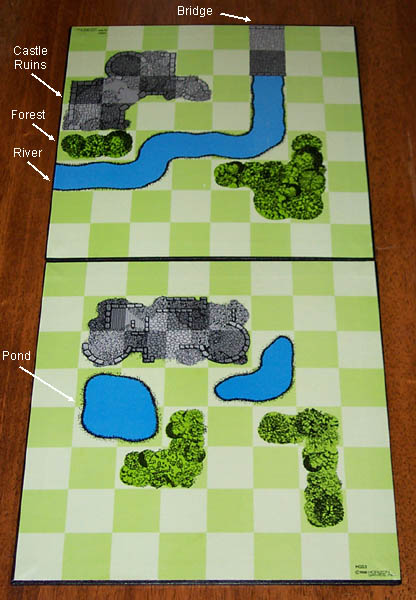
Sample: two board sections from the game.
The game is a 2-4 player chess variant which uses nine board sections which can be placed together in various ways. The board sections are checkered with an 8x8 grid pattern like a chess board, but there are also terrain markers on various squares which influence the movements of the chess pieces.
The pieces used in the game are the standard orthodox chess pieces. Ignoring terrain, the King, Rook, Bishop and Queen move as in orthodox chess. The Knight moves as the orthodox chess equivalent, but may also leap three squares in any orthogonal or diagonal direction (ie. it is also a 3-3 leaper and a 0-3 leaper).
The Pawn moves (non-capturing) one, two or three squares in any forward or sideways direction (ie. straight ahead, diagonally forward, or sideways). Like its chess counterpart, the Sceptre Pawn captures only on the diagonally forward squares directly adjacent to it. Pawns may promote to a captured piece upon reaching an open ground square on the opposite rank.
The above movement rules apply to pieces when they move over open ground terrain. When moving into or over other types of terrain, there are specific rules which limit the movements of the pieces. These rules are specified in the following section.
| Piece | Forest | River/Pond | Bridge | Castle Ruin |
|---|---|---|---|---|
| King | Normal | Cannot move into | Normal | Cannot move into |
| Queen | Normal | Cannot move into or across | Normal | Cannot move into or across |
| Rook | Cannot move into or across | Cannot move into or across | Normal | One square per turn. Must stop on adjacent square before entering. |
| Bishop | One square per turn. Must stop on adjacent square before entering. | Cannot move into or across | Normal | Cannot move into or across |
| Knight | Normal | Normal | Normal | Cannot move into |
| Pawn | Normal | May move across or along. Cannot cross a river in one turn. Limited to one square per turn when moving along a river, but may also move backwards. Cannot move into or across a Pond. | Normal | One square per turn. Must stop on adjacent square before entering. |
There are few restrictions stated in the rules about how the board sections can be layed out. I assume that all board sections must be 'connected' in some way, although they do not have to form a rectangle, or any other regular shape.
A player who captures another player's King, gains control of that player's pieces. The pawns retain their direction, but the pieces are now moved on the turn of the capturing player. A player may still only move one piece per turn, regardless of how many different armies they control.
A player may not move his King into check. If a player cannot move and is not in check, then the player's pieces can no longer move, and the owning player is removed from the game. The pieces are not controlled by any player.

Sample: two board sections from the game. |
The set is composed of nine 8x8 boards, each with a unique terrain landscape; and four chess piece sets (one black, one white, one red and one yellow). Each piece set is composed of the standard 16 chess pieces (1 King, 1 Queen, 2 Rooks, 2 Bishops, 2 Knights, and 8 pawns). Rules are included, along with four terrain effect cards which give a summary of the terrain limitations for the various pieces).
------------------------- HORIZON GAMES, INC. P.O. Box 701 Plainfield, Indiana 46168 -------------------------